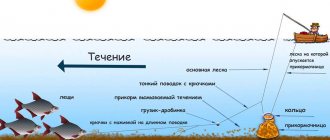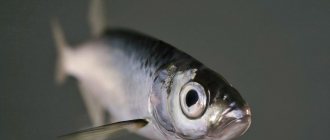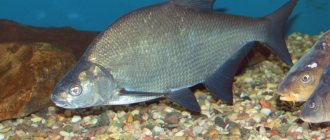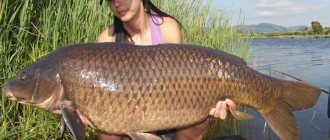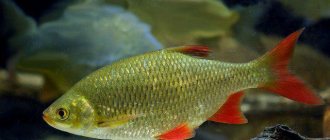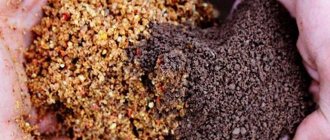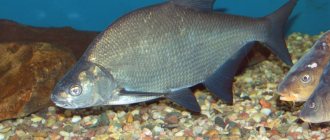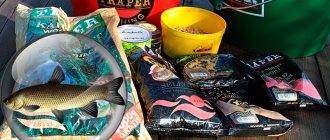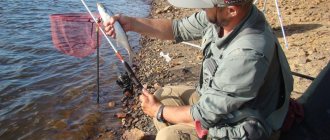Custer. What, how, why and why
Without a doubt, maggot - the larva of a fly - is one of the most popular baits among white fish anglers. Unpretentiousness in storage, durability and endurance - these and many other features make it an excellent option for catching a wide variety of fish, from bleak to large bream. And yet these larvae have one weak point. Once you leave them in the sun for several hours, the larvae begin to pupate and turn into a fly. When many fishermen see these brown pupae in a jar, they simply throw them away. And, by the way, it’s completely in vain - these pupae are an excellent bait for catching large white fish, primarily roach and bream!
What is caster?
Before turning into a fly, the maggot turns into an intermediate stage - a dark pupa, with a thin chitinous cocoon, inside of which there is soft content. This form is called caster and is well known to float anglers and feeder fishermen. Caster is widely used both as bait and as an additive to groundbait when fishing for various types of whitefish. Moreover, the situation sometimes develops in an extremely interesting way - when only small fish take the maggot, confident bites of large roach, bream and bream occur on the caster.
However, not all casters are equally useful! Just like yoghurts! The thing is that along the way of transformation from a maggot to a fly, the caster also changes its physical state, turning from a soft white pupa into a black, dry and shrunken “grain”. It is from the latter that the young fly subsequently flies out. And it is precisely these “crackers” that are not suitable for fishing - they are not only very tender and are easily torn off the hook by fish, but also have positive buoyancy.
In a word, it is not enough to simply wait for the maggot to pupate; you need to stop the process at a certain stage. The correct caster, suitable for use as bait and a component for groundbait, has a dense, elastic body, a color from soft cream to light brown, and its buoyancy is necessarily negative. This is how this larva appears at the very beginning of the pupation process, and at this stage the metamorphosis must be stopped. The easiest way is to deprive the pupa of oxygen, place it in cold water and keep it until the very moment of fishing.
When “growing” such a caster, it is necessary to carefully control the pupation process and not skip the pupation process. For this purpose, the larvae that have begun to transform should be lowered into water at certain intervals and those that will drown should be selected.
Caster as a component for bait
In order to effectively use caster as bait, it is necessary to accustom the fish to it, because not everywhere this bait works effectively from the very beginning of fishing. For this purpose, a certain amount of caster must be added to the bait, thus accustoming the fish to it.
You can add larvae in one of three ways:
· Entirely. A handful or two of caster is poured into a container with bait, mixed and formed into balls. In the feeder, larvae are added with plugs to each feeder and clamped at both ends with groundbait;
· Pressed. Before introducing the caster into the bait, the larvae are crushed by hand, “letting the juice out.” This additive has an excellent effect on roach, silver bream, bream and bream, attracting them to the fishing point and forcing them to look for food;
· In cut form. The essence is similar to the second method, but here the larvae are turned into “minced meat” using scissors. Subsequently, it is this that is introduced into the bait. This additive has an extremely positive effect on white fish. During cooking, you can make a “mix” by cutting bloodworms, maggots, worms or corn together with the caster, and also adding liquid and dry aromatics;
In the case when caster is added to the bait in crushed or cut form, it must be remembered that the liquid secreted by the larvae can over-moisten the bait, change its mechanics, or even turn it into “plasticine” if we are talking about heavy and sticky river bait. If a fisherman plans to use caster in bait, the mixture must be under-moistened initially - having received moisture from the caster, it will become as needed in specific fishing conditions.
Caster as a nozzle
This doll is also widely used on a hook. The result is obtained both by independent use on a hook in the amount of 1-2 pieces, and by use as part of a sandwich with corn grain, 2-3 bloodworms, maggots or a small worm. It is best to select a specific “recipe” empirically, focusing on the preferences of the fish at the current moment. The general rules are as follows: roach and silver bream are fine with pure caster or a caster sandwich with maggots. Bream, white bream, chub and ide respond better to replanting with a worm, bloodworms or corn.
We should not forget that caster is a rather delicate bait, and therefore the use of thick and large hooks is not suitable here. Preference should be given to miniature hooks made of thin wire with a wide hook and a tip bent inward. The size is selected depending on the composition of the bait and the intended production. For fishing with 1-2 casters, hooks of 14-16 numbers are used, but when replanting corn or a worm, it makes sense to enlarge to number 12.
The caster is a very specific bait that requires the angler to have certain skills when using it. However, once he understands all the intricacies of use, the results will not be long in coming.
Four ages of princess
The life of casters is even more fleeting than that of maggots. The process of transition from larva to fly can be divided into 4 stages (photo 1) . And if proper measures are not taken to slow down their development, casters turn into a dark brown pupa in just a few hours (photo 2) . And the dark pupa is heavily filled with air - and therefore floats in the water. And its shell becomes very fragile.
So overripe pupae are only suitable for bait. And even then in a crushed form. Only cream and light brown colored pupae are suitable for hook baiting (photo 3) , so they drown in the water. These contain the highest content of substances attractive to fish, and the shell is still elastic enough to withstand the bite of fish.
Now I buy the number of casters I need at a fishing store. They are sold in vacuum packaging and have a fairly long shelf life - up to two weeks when sealed. A half-liter package of pupae is enough for both bait and bait.
The technology for preparing casters at home is simple, but quite time-consuming. Maggots intended for pupation are passed through a 3-mm sieve several times a day and the larvae that have stopped moving are selected. To slow down their further development, young pupae are placed in a refrigerator in a container of water. The water needs to be changed every day, otherwise the pupae will spoil. By the way, casters are stored in the same way when fishing. If you do not fill them with water, in the open air, within an hour after opening the package, almost all pupae turn dark brown.
Cooking recipes
Pupated maggots attract fish from the carp family. If you see that a pupa has appeared, do not rush to throw it in the trash. It will be an excellent bait or lure for large fish.
How to make casters for fishing? Just buy maggots and place them in the shade. In a week they will pupate. The pupae will be of different colors, but only light brown ones will suit you.
There is another way to find out which dolls are not suitable:
- Pour water into the container.
- Pour in casters.
- Those that have surfaced are not suitable as bait.
- Take a sieve and select them. These dolls will make excellent bait.
- The remaining casters are selected from the water and placed in a box. This is bait.
If the fish bites right at the surface, it is recommended to feed the bait using a bait slingshot. Just pour a handful of pupae into the fishing area. It is also worth using casters from the bottom of the box.
When fishing in the bottom layers, bait casters should be crushed and then mixed with the bait mixture.
There is another way to prepare casters:
- Pass the maggots through a fine sieve, separating the living from the dead.
- Cover the maggot with slightly damp sawdust and put it in the refrigerator.
- Remove the box of maggots a few days before fishing.
- Sift, remove dead maggots, and store the remaining ones in a warm place until casters form.
- When you receive light brown casters, select them immediately. Leave the rest until ripe.
- Carry out the procedure every 4 hours.
- Place the selected casters again in the refrigerator in a plastic bag. They can be stored in this form for a week.
Feeding
As noted above, when fishing with casters, the most effective way to feed fish is to regularly throw small portions of bait to the float. But there are times when there is a weak current in the reservoir, and in order to maintain the compactness of the feeding “spot”, it is necessary to use additional weights. The simplest option is to mix casters with a small amount of soil.
Casters are maggot pupae. They are a popular bait among fishermen. Let's take a closer look at what casters are and how to prepare them for fishing.
How to bait and catch
The best option is to attach a caster hook to a caster hook in combination with maggots. In this case, the caster must be the last. When using feeder fishing, it is recommended to add pupae to the bait. But this is not necessary if the fish is already familiar with the presented bait. If you use casters for a long time, you will notice that the size of the fish increases. Bream and large bream are caught well on the pupa.
The British believe that maggots are the best option for small fish. And large fish are excellently caught using caster, especially white fish. Among other things, it was noticed that different casters, depending on aging, have different properties. Thus, a newly pupated pupa is rich in protein. It sinks quickly and differs from maggots in that its shell is harder. An older caster will float, and the amount of protein in it is slightly lower. The oldest pupae are dark brown.
Most often, the presented bait is used in the West. There are even competitions for fishing with casters and maggots. At first, maggots take the lead, but only if they were planted whole and did not leak out. Pupae are lighter and constantly strive to raise the hook to the surface of the water; they are more noticeable and allow you to catch cautious fish. The caster attachment is applied in the classic way - using the thick end. It has been noticed that the bream takes the pupa much more confidently and swallows it deeper. All of the above brings us to the fact that when fishing you will have to experiment to understand what kind of bait in a particular area interests the fish.
When choosing a caster, you should be prepared for the fact that you will have to cast 4-5 times. In this case, bait in the form of pupae is required. The fish will taste the bait and gradually develop a taste for it.
Some branded casters are sold in special bags of water. This helps to stop the pupation process until air reaches the pupa. The storage time of the presented bait is 1.5 weeks.
Dead maggots
I became acquainted with this derivative product of maggot production a little later than with casters. And this also happened thanks to translated articles by English masters of white fish fishing. The British have been using dead maggots for a long time and with great efficiency, both as a component of groundbait and as independent bait. Most often, they used dead maggots when catching bream. So I remembered this bait when several years ago I found a herd of large bream in one deep river oxbow. Bronze beauties weighing 3-4 kg are an exceptional rarity for the river.
And here they were caught properly. There was just one “but” that got in the way. In this oxbow lake, bream responded best to maggots. Accordingly, maggots were added in large quantities to the bait. And then one interesting feature became clear. On some days, the bream reacted very reluctantly to the starter feeding. But if it was possible to collect it from the bait, additional supplementary feeding with bait balls stuffed with maggots was an absolute success.
Analyzing my actions, I came to the conclusion that the reason most likely lies in the mobility of maggots. These fast-crawling larvae manage to scatter from the bait even before the first fish get there. They had to be immobilized somehow. The first time I did it using boiling water. I poured boiling water from a thermos into the container with maggots, waited about a minute and drained the water. The maggots stopped moving.
This action was a success. The scalded maggots did not loosen the bait and remained lying on the bottom, waiting for the fish to approach. Bream began to gather for complementary food much more willingly. Subsequently, in order not to carry around a thermos of boiling water, I began to kill the maggots, placing them in several tightly tied bags before fishing. Before placing them in the bag, I separated them from the sawdust in which they are most often sold. The larvae die after 12 hours. Then the maggots are packaged into portions and frozen. Before fishing, I take out the required amount of maggots from the freezer, and by the time I get to the reservoir, the bait acquires the condition I need. To speed up the defrosting process, upon arrival at the pond, I place them in a bait container and fill them with water. Compared to scalding, this method of killing maggots seemed to me more productive. After defrosting, such maggots had a very delicate and soft structure, which the fish really liked.
The larvae scalded with boiling water still have time to cook a little and become tougher.
Not only bream turned out to be big fans of dead maggots. I used this bait no less successfully to catch tench. In our area, one of the most delicious baits for catching tench before spawning are maggots. The problem with using this bait is that next to the tench on the grassy shallows there are a lot of small roach and rudd, which are serious competitors for the tench.
A live maggot, even if placed inside a ball of bait, very quickly crawls out and becomes easy prey for small fish. She quickly eats up the treat, and the tench is left with only the plant component of the bait, which he doesn’t really like. With dead maggots, it turned out to be much easier to collect tench for bait. Rolled into balls, they calmly waited for the approach of those for whom the bait was, in fact, intended.
The use of dead maggots as bait also turned out to be interesting. Everyone knows that when catching live maggots, the biggest problem is the very high interest in it from small fish. Seeing a tasty bait on a hook, bleak often attacks even a feeder rig with a 100 gram feeder, and manages to nibble all 6-8 larvae while they sink to the bottom. And in order to get rid of unwanted bites, you often have to switch to another bait, or even change location. The problem was solved when I switched to using dead maggots. Bites of unwanted small fish became more rare, but the bream began to find the bait much faster. It even seemed to me that dead maggots were more noticeable against the background of bottom debris. Apparently, the fish readily grabs them, believing that the larvae have been lying here for a long time and does not associate them with danger.
And last year I saw vacuum-packed dead maggots in a store. It turned out that this wonderful bait is supplied by the same maggot manufacturers that also make vacuum-packed casters. In terms of quality, “pickled maggots” (as they are called in stores) turned out to be even better than those produced independently. Thanks to vacuum packaging, the killed larvae were not frozen, and their structure became even softer. Local bream have already appreciated the new bait. Try fishing with these great baits. I’m sure the results of your fishing will pleasantly surprise you!
Equipment
When fishing with casters, it is very important to follow certain rules for presenting bait. Here (almost like when fishing with steamed cereals) to achieve the best result, the bait on the hook should be lowered, surrounded by bait freely falling in the water. That’s why I choose equipment such as for fishing with steamed grains.
The basis of my rigs are floats with a spindle-shaped body with a carrying capacity of 1.25 - 1.5 g (photo 4) . I choose lighter floats when I fish in a calm or with the wind blowing at my back, and with heavy floats I fish in a side or head wind. The antenna of the float must be thin - no thicker than 1.25 mm. With a thicker antenna, you may not see even half of the cautious bites.
The loading scheme is a chain of sinkers of decreasing weight. The optimal number of weights is 5 - 7 pieces (photo 5) . Of course, the float loading scheme in the English style - the “buttons on a shirt” type (when 7 - 8 sinkers of the same mass are attached to the fishing line at equal intervals) - allows for a more believable presentation of the bait. But it is good for plug rods, but when working with a fly rod, equipment built according to this scheme often gets confused when casting. Especially if you have to swing a lot because of the wind.
The leash must be thin and not very long. The length of the leashes on my fishing rods ranges from 10 to 15 cm. And their diameter is 0.085 mm. If you have a monolithic tip on the rod and some dexterity when fishing for fish, the power of the line on the leash is quite enough to fish for fish weighing 0.3 - 0.5 kg. And only in the most exceptional cases, when bream or tench are expected in the trophies, do I use a leash with a diameter of 0.108 mm (photo 6) .
For caster fishing you need reliable hooks of the smallest size. Most often I use hooks No. 18 - 20 made of wire with a cross section of 0.32 - 0.35 mm. Such small hooks have little mass, so the caster applied to them (photo 7) behaves very naturally in the water.

